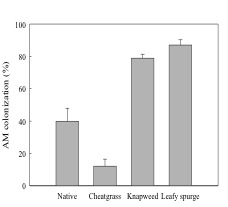Impacts of Plant Invasions
Block title
Impacts of Plant Invasions
Ylva Lekberg shares MPG research into how plant invasions affect AM fungal communities.
Invasions of cheatgrass (Bromus tectorum), leafy spurge (Euphorbia esula) and knapweed (Centaurea stoebe) cover extensive areas of the ranch and the region. All three plants form a root symbiosis with arbuscular mycorrhizal (AM) fungi in which the fungus exchanges phosphorus and possibly other services for plant carbon.
To determine how cheatgrass, knapweed and leafy spurge invasions affect AM fungal communities, we use traditional microscopy (Image 1) and massive parallel sequencing of ribosome genes. Our initial results show that knapweed and leafy spurge increase fungal abundance (Figure 1) and fungal species richness relative to the native remnant plants. Cheatgrass shows the opposite trend. Fungal communities also differ among the three invasive plants, which suggests that broad generalizations among invasive plants should be avoided.
Our goal is to link invasion-mediated structural changes in fungal communities with potential shifts in mycorrhizal function. To assess function, we will use stable isotope probing to measure carbon allocation from plants to fungi, and recently developed nano-technology to track reciprocal phosphorus delivery from fungus to plant. Overall, this work will increase our understanding of the role of AM fungi for plant invasive success, and help guide restoration efforts for the re-establishment of native plant communities.

Image 1. AM fungal structures stained dark blue in leafy spurge roots. Vesicles are oval lipid storage structures and hyphae are thin strands that the fungus uses to spread inside the root and throughout the soil.

Figure 1. Percentage of root intercepts that are colonized by AM fungi in native plants, cheatgrass, knapweed and leafy spurge roots collected from six locations in and around Missoula, including MPG Ranch.
